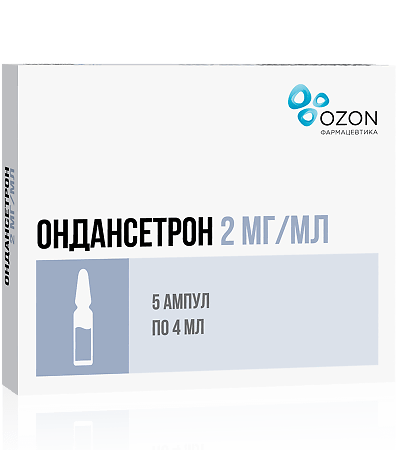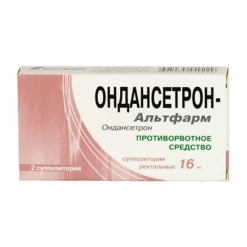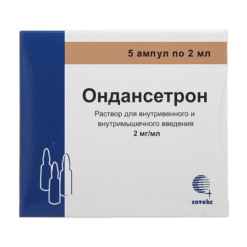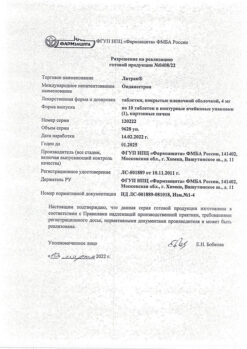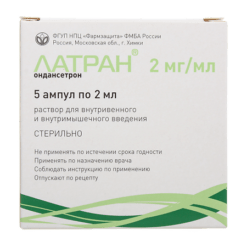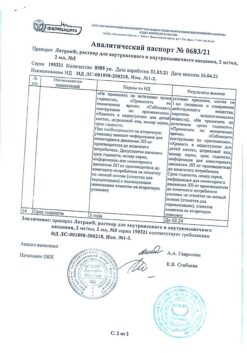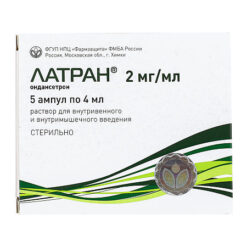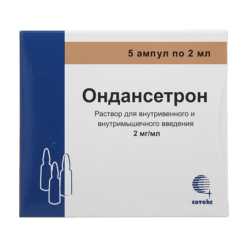No products in the cart.
Ondansetron, 2 mg/ml 4 ml 5 pcs
€8.11 €6.93
Description
Pharmacotherapeutic group:
A serotonin receptor antagonist anti-emetic
ATX code:
A04AA01
Pharmacological properties
Pharmacodynamics
Ondansetron is a selective 5-NT3 (serotonin) receptor antagonist. Cytostatic chemotherapy drugs and radiotherapy may increase serotonin levels which by activating afferent fibers of the vagus nerve containing 5-HT3 receptors, causes the gag reflex.
Ondansetron selectively blocks serotonin 5-NT3 receptors in neurons of the central (gag center) and peripheral (gastrointestinal tract) nervous system that regulate the gag reflex.
Does not impair coordination of movements, does not cause sedation and decreased performance. Does not change the concentration of prolactin in plasma.
Pharmacokinetics
In intramuscular administration the peak concentration (TSmax) in plasma is reached within 10 minutes. The distribution of ondansetron is the same with oral, intramuscular and intravenous administration. Bioavailability is about 60%. The drug is metabolized in the liver. Binding to plasma proteins is 70-76%. The volume of distribution is 140 l. Period of half-life (T1/2) is 3 hours, in elderly patients it can be up to 5 hours and in case of marked hepatic insufficiency – 15-20 hours.
It is eliminated from systemic blood flow mainly as a result of metabolism in liver, which occurs with the participation of several liver microsomal enzymes (CYP1A2, CYP2D6, CYP3A4). Absence of CYP2D6 isoenzyme has no effect on ondansetron pharmacokinetics. Less than 5% of the administered dose is excreted unchanged in the urine. Pharmacokinetic parameters of ondansetron do not change with its repeated administration. In patients with moderate renal insufficiency (creatinine clearance 15-60 ml/min) both systemic clearance and volume of distribution of ondansetron are reduced, resulting in a small and clinically insignificant increase in T1/2 (up to 5.4 h).
The pharmacokinetics of ondansetron are virtually unchanged in patients with severe renal impairment who are on chronic hemodialysis. In patients with severe hepatic impairment, systemic clearance of ondansetron is sharply reduced, resulting in prolongation of its half-life (up to 15-32 h).
Indications
Indications
prevention and relief of nausea and vomiting caused by cytostatic chemotherapy, cytostatic radiotherapy;
prevention and relief of postoperative nausea and vomiting.
Pharmacological effect
Pharmacological effect
Pharmacotherapeutic group:
antiemetic – serotonin receptor antagonist
ATX Code:
A04AA01
Pharmacological properties
Pharmacodynamics
Ondansetron is a selective 5-HT3 (serotonin) receptor antagonist. Cytostatic chemotherapy drugs and radiotherapy can cause an increase in serotonin levels, which, by activating vagal afferent fibers containing 5-HT3 receptors, causes the gag reflex.
Ondansetron selectively blocks serotonin 5-HT3 receptors of neurons of the central (vomiting center) and peripheral (gastrointestinal tract) nervous system, which regulates the gag reflex.
Does not interfere with coordination of movements, does not cause sedation or decreased performance. Does not change the concentration of prolactin in plasma.
Pharmacokinetics
When administered intramuscularly, peak concentration (TCmax) in plasma is achieved within 10 minutes. The distribution of ondansetron is similar when administered orally, intramuscularly, and intravenously. Bioavailability is about 60%. The drug is metabolized in the liver. Plasma protein binding is 70-76%. The distribution volume is 140 l. The half-life (T1/2) is 3 hours, in elderly patients it can reach 5 hours, and in case of severe liver failure – 15-20 hours.
It is eliminated from the systemic circulation mainly as a result of metabolism in the liver, which occurs with the participation of several microsomal liver enzymes (CYP1A2, CYP2D6, CYP3A4). The absence of the CYP2D6 isoenzyme does not affect the pharmacokinetics of ondansetron. Less than 5% of the administered dose is excreted unchanged in the urine. The pharmacokinetic parameters of ondansetron do not change with repeated administration. In patients with moderate renal failure (creatinine clearance 15-60 ml/min), both systemic clearance and volume of distribution of ondansetron are reduced, resulting in a small and clinically insignificant increase in T1/2 (up to 5.4 hours).
The pharmacokinetics of ondansetron remain virtually unchanged in patients with severe renal impairment undergoing chronic hemodialysis. In patients with severe liver dysfunction, the systemic clearance of ondansetron is sharply reduced, resulting in an increase in its half-life (up to 15-32 hours).
Special instructions
Special instructions
Patients who have previously had allergic reactions to other selective 5-HT3 receptor blockers have an increased risk of developing them with ondansetron. Ondansetron can slow down the motility of the large intestine, and therefore its use in patients with signs of intestinal obstruction requires special monitoring.
The infusion solution must be prepared immediately before use.
If necessary, the prepared infusion solution can be stored until use for a maximum of 24 hours at a temperature of 2-8 ‘C under normal lighting conditions. No protection from light is required during the infusion; The diluted injection solution remains stable for at least 24 hours in natural light or normal lighting.
Active ingredient
Active ingredient
Ondansetron
Composition
Composition
1 ampoule (2 ml) of solution contains ondansetron hydrochloride dihydrate as the active substance (in terms of ondansetron base) – 4.0 mg;
excipients: citric acid monohydrate – 1.1 mg, sodium citrate pentasesquihydrate – 0.66 mg or sodium citrate dihydrate – 0.55 mg, sorbitol – 96.0 mg, water for injection – up to 2.0 ml.
Contraindications
Contraindications
hypersensitivity to any component of the drug;
pregnancy and lactation;
children under 2 years of age (safety and effectiveness of use have not been studied).
Side Effects
Side Effects
From the digestive system: hiccups, dry mouth, diarrhea or constipation, sometimes asymptomatic transient increases in serum aminotransferase levels.
From the cardiovascular system: chest pain, in some cases with ST segment depression, arrhythmias, bradycardia, decreased blood pressure.
From the nervous system: headache, dizziness, spontaneous movement disorders and convulsions.
Allergic reactions: urticaria, bronchospasm, laryngospasm, angioedema, anaphylaxis.
Local reactions: pain, burning and redness at the injection site.
Other: “flush” of blood to the face, feeling of heat, temporary impairment of visual acuity, hypokalemia, hypercreatininemia.
Interaction
Interaction
Since ondansetron is metabolized by the enzyme system (cytochrome P450) of the liver, caution is required when used together:
– with P450 enzymatic inducers (CYP2D6 and CYP3A) – barbiturates, carbamazepine, carisoprodol, glutethimide, griseofulvin, dinitrogen oxide, papaverine, phenylbutazone, phenytoin (probably other hydantoins), rifampicin, tolbutamide;
– with inhibitors of P450 enzymes (CYP2D6 and CYP3A) – allopurinol, macrolide antibiotics, antidepressants (MAO inhibitors), chloramphenicol, cimetidine, estrogen-containing oral contraceptives, diltiazem, disulfiram, valproic acid and its salts, erythromycin, fluconazole, fluoroquinolones, isoniazid, ketoconazole, lovastatin, metronidazole, omeprazole, propranolol, quinidine, quinine, verapamil.
Ondansetron at a concentration of 16-160 mcg/ml is pharmaceutically compatible and can be administered via a Y-shaped injector intravenously in combination with the following drugs:
– cisplastin (at a concentration of up to 0.48 mg/ml) for 1-8 hours;
– 5-fluorouracil (at concentrations up to 0.8 mg/ml at a rate of 20 ml/h – higher concentrations may cause precipitation of ondansetron);
– carboplatin (at a concentration of 0.18-9.9 mg/ml for 10-60 minutes);
– etoposide (at a concentration of 0.14-0.25 mg/ml for 30-60 minutes);
– ceftazidime (at a dose of 0.25-2 g, as an intravenous bolus injection over 5 minutes);
– cyclophosphamide (in a dose of 0.1-1 g, as an intravenous bolus injection over 5 minutes);
– doxorubicin (at a dose of 10-100 mg, as an intravenous bolus injection over 5 minutes);
The drug can be administered through one dropper, while in solution the concentration of dexamethasone sodium phosphate can range from 32 to 2500 μg/ml, ondansetron – from 8 to 100 μg/ml.
Overdose
Overdose
Symptoms: in most cases similar to adverse reactions when using the drug in recommended doses.
Treatment: there is no specific antidote. In cases of suspected overdose, symptomatic and supportive therapy is indicated.
Shelf life
Shelf life
5 years. Do not use after the expiration date stated on the package.
Manufacturer
Manufacturer
Ozon, Russia
Additional information
| Shelf life | 5 years. Do not use after the expiration date printed on the package. |
|---|---|
| Manufacturer | Ozon, Russia |
| Medication form | solution |
| Brand | Ozon |
Other forms…
Related products
Buy Ondansetron, 2 mg/ml 4 ml 5 pcs with delivery to USA, UK, Europe and over 120 other countries.

